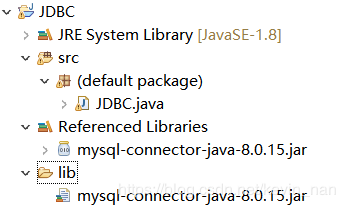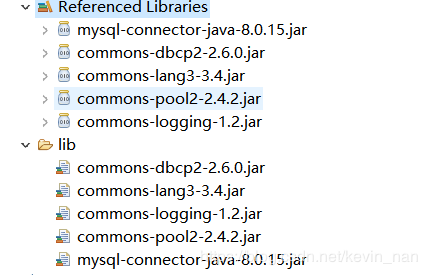安装好mysql数据库 安装后检查是否有connection J 的程序
第一步导入架包,加载驱动程序 发起请求

第一步的程序
url 如果写成 jdbc:mysql://localhost:3306/student?useUnicode=true&characterEncoding=utf8 ; 有可能会报错
——>java.sql.SQLException: The server time zone value ........ 这时候参考博文:https://blog.csdn.net/Hello_World_QWP/article/details/80421533
也就是用下面我的url 里 +?......的部分
Class.forName("com.mysql.jdbc.Driver");//一般都是已经加载好的 加入后可能会警告
System.out.println("驱动加载成功");
String url = "jdbc:mysql://localhost:3306/mysql2_1709?serverTimezone=UTC";
String user = "root";
String password = "88888888";
Connection con = DriverManager.getConnection(url, user, password);
第二步进行语句操作 查询完关闭
//第二步 进行语句操作
Scanner sc = new Scanner(System.in); //可以输入sql查询语句
Statement stm = con.createStatement();
System.out.println("输入sql语句");
String sql = sc.nextLine();
ResultSet res = stm.executeQuery(sql);
while(res.next()) {//输出结果集
System.out.println(res.getInt(1)+","+res.getString(2)+","+res.getString(3));
}
if(res!=null)
try {
res.close();
} catch (SQLException e) {
e.printStackTrace();
}
if(pstm !=null)
try {
pstm.close();
} catch (SQLException e) {
e.printStackTrace();
}
if(con !=null)
try {
con.close();
} catch (SQLException e) {
e.printStackTrace();
}
完整代码
import java.sql.DriverManager;
import java.sql.ResultSet;
import java.sql.SQLException;
import java.sql.Statement;
import java.util.Scanner;
import java.sql.Connection;
public class JDBC {
public static void main(String[] args) {
// 第一步 导入架包 加载驱动程序
// Class.forName("com.mysql.jdbc.Driver");//一般都是已经加载好的
System.out.println("驱动加载成功");
String url = "jdbc:mysql://localhost:3306/mysql2_1709?serverTimezone=UTC";
String user = "root";
String password = "88888888";
Connection con = null;
Statement stm = null;
ResultSet res = null;
try {
con = DriverManager.getConnection(url, user, password);
Scanner sc = new Scanner(System.in);
stm = con.createStatement();
System.out.println("输入sql语句");
String sql = sc.nextLine();
res = stm.executeQuery(sql);
while (res.next()) {
System.out.println(res.getInt(1) + "," + res.getString(2) + "," + res.getString(3));
}
}
catch (SQLException e) {
e.printStackTrace();
}
finally {// 每个关闭语句都要单独 放 不然一个有异常 会导致其他资源的关闭
if(res!=null)
try {
res.close();
} catch (SQLException e) {
e.printStackTrace();
}
if(pstm !=null)
try {
pstm.close();
} catch (SQLException e) {
e.printStackTrace();
}
if(con !=null)
try {
con.close();
} catch (SQLException e) {
e.printStackTrace();
}
}
// 第二步 进行语句操作
}
}
查询语句可以改为
System.out.println(res.getInt("id") + "," + res.getString("name") + "," + res.getString("sex"));
整理代码 把操作写到方法里面
查询数据库所有信息
public static void selectAll() {
Connection con = null;
Statement stm = null;
ResultSet res = null;
try {
con = DriverManager.getConnection(url, user, password);
Scanner sc = new Scanner(System.in);
stm = con.createStatement();
res = stm.executeQuery("select * from t1_user");
while (res.next()) {
System.out.println(res.getInt("id") + "," + res.getString("name") + "," + res.getString("sex"));
}
}
catch (SQLException e) {
e.printStackTrace();
}
// 每个关闭语句都要单独 放 不然一个有异常 会导致其他资源的关闭
finally {
if(res!=null)
try {
res.close();
} catch (SQLException e) {
e.printStackTrace();
}
if(pstm !=null)
try {
pstm.close();
} catch (SQLException e) {
e.printStackTrace();
}
if(con !=null)
try {
con.close();
} catch (SQLException e) {
e.printStackTrace();
}
}
}
通过 指定的id 和name 来查询
注意 namevalue 要用单引号括起来
public static boolean selectByIdName(String id, String name) {// 查询语句是否存在指定的id 以及 name
Connection con = null;
Statement sta = null;
ResultSet res = null;
try {
con = DriverManager.getConnection(url, user, password);
sta = con.createStatement();
res = sta.executeQuery("select * from t1_user where id= " + id + " and name = '" + name + "'");
// 有数据就返回true 并输出相对应的信息
if (res.next()) {
while (res.next()) {
System.out.println(res.getInt("id") + "," + res.getString("name"));
}
return true;
}
else
return false;
}
catch (Exception e) {
e.printStackTrace();
}
finally {
if(res!=null)
try {
res.close();
} catch (SQLException e) {
e.printStackTrace();
}
if(pstm !=null)
try {
pstm.close();
} catch (SQLException e) {
e.printStackTrace();
}
if(con !=null)
try {
con.close();
} catch (SQLException e) {
e.printStackTrace();
}
}
return false;
}
}
数据库要小心sql注入 被黑客攻击的漏洞 id 和 name 是数据库里面没有的 结果还输出数据

防止sql注入 采用 preparedstatement 语句
将上面sql定义的数据改写为
Connection con = null;
PreparedStatement psta = null;
ResultSet res = null;
try {
con = DriverManager.getConnection(url, user, password);
String sql = "select * from t1_user where id = ? and name = ?";
psta = con.prepareStatement(sql);//创建后再设置参数
psta.setInt(1, id);
psta.setString(2, name);
res = psta.executeQuery();//记得要赋值给 res
分页查询
limit 查询的方法 查询第几页
public static void selectUserByPage(int pageNumber , int pageCount) {
Connection con = null;
PreparedStatement pstm =null;
ResultSet res = null;
try {
con = DriverManager.getConnection(url,user,password);
String sql = "select * from t1_user limit ? , ?";
pstm = con.prepareStatement(sql);
pstm.setInt(1, (pageNumber-1)*pageCount);
pstm.setInt(2, pageCount);
res = pstm.executeQuery();
while(res.next()) {
System.out.println(res.getInt(1)+","+res.getString(2)+",");
}
}
catch (Exception e) {
System.out.println(e);
}finally {
if(res!=null)
try {
res.close();
} catch (SQLException e) {
e.printStackTrace();
}
if(pstm !=null)
try {
pstm.close();
} catch (SQLException e) {
e.printStackTrace();
}
if(con !=null)
try {
con.close();
} catch (SQLException e) {
e.printStackTrace();
}
}
}
对代码进行整合(重复代码放到一个工具类中) 以及实现一些小功能
import java.sql.Connection;
import java.sql.DriverManager;
import java.sql.PreparedStatement;
import java.sql.ResultSet;
import java.sql.SQLException;
import java.sql.Statement;
import java.util.Scanner;
public class JDBCUtills {
private static final String url = "jdbc:mysql://localhost:3306/mysql2_1709?serverTimezone=UTC";
public static Connection getConn() {
Scanner sc = new Scanner(System.in);
System.out.println("输入登陆账号");
String user = sc.nextLine();
System.out.println("输入密码");
String password = sc.nextLine();
Connection con = null;
PreparedStatement pstm =null;
ResultSet res = null;
try {
con = DriverManager.getConnection(url,user,password);
System.out.println("登陆成功");
return con;
}
catch (Exception e) {
System.out.println("密码账号出错");
}
return con;
}
public static void close(ResultSet res, PreparedStatement pstm, Connection con) {
if(res!=null)
try {
res.close();
} catch (SQLException e) {
e.printStackTrace();
}
if(pstm !=null)
try {
pstm.close();
} catch (SQLException e) {
e.printStackTrace();
}
if(con != null)
try {
con.close();
} catch (SQLException e) {
e.printStackTrace();
}
}
public static void close(ResultSet res, Statement stm, Connection con) {
if(res!=null)
try {
res.close();
} catch (SQLException e) {
e.printStackTrace();
}
if(stm !=null)
try {
stm.close();
} catch (SQLException e) {
e.printStackTrace();
}
if(con != null)
try {
con.close();
} catch (SQLException e) {
e.printStackTrace();
}
}
}
import java.sql.DriverManager;
import java.sql.PreparedStatement;
import java.sql.ResultSet;
import java.sql.SQLException;
import java.sql.Statement;
import java.util.Scanner;
import java.sql.Connection;
public class JDBC {
static String user;
static String password;
static String url;
static Connection con;
public static void main(String[] args) {
Scanner sc = new Scanner(System.in);
con = JDBCUtills.getConn();
if (con != null)
selectAll();
}
public static void selectAll() {
Statement stm = null;
ResultSet res = null;
try {
stm = con.createStatement();
res = stm.executeQuery("select * from t1_user");
while (res.next())
System.out.println(res.getInt("id") + "," + res.getString("name") + "," + res.getString("sex"));
}
catch (SQLException e) {
e.printStackTrace();
}
finally {// 每个关闭语句都要单独 放 不然一个有异常 会导致其他资源的关闭
JDBCUtills.close(res, stm, con);
}
}
public static boolean selectByIdName(int id, String name) {// 查询语句是否存在指定的id 以及 name
PreparedStatement psta = null;
ResultSet res = null;
try {
String sql = "select * from t1_user where id = ? and name = ?";
psta = con.prepareStatement(sql);// 创建后再设置参数
psta.setInt(1, id);
psta.setString(2, name);
res = psta.executeQuery();
// 有数据就返回true 并输出相对应的信息
if (res.next()) {
while (res.next())
System.out.println(res.getInt("id") + "," + res.getString("name"));
return true;
}
else
return false;
}
catch (Exception e) {
e.printStackTrace();
}
finally {
JDBCUtills.close(res, psta, con);
}
return false;
}
public static void selectUserByPage(int pageNumber, int pageCount) {
PreparedStatement pstm = null;
ResultSet res = null;
try {
String sql = "select * from t1_user limit ? , ?";
pstm = con.prepareStatement(sql);
pstm.setInt(1, (pageNumber - 1) * pageCount);
pstm.setInt(2, pageCount);
res = pstm.executeQuery();
while (res.next()) {
System.out.println(res.getInt(1) + "," + res.getString(2) + ",");
}
} catch (Exception e) {
System.out.println(e);
} finally {
JDBCUtills.close(res, pstm, con);
}
}
}
插入语句的实现代码
public static void insert(int id , String name , String sex) {
PreparedStatement pstm = null;
ResultSet res = null;
try {
String sql = "insert into t1_user(id,name,sex) values(?,?,?)";
pstm = con.prepareStatement(sql);
pstm.setInt(1, id);
pstm.setString(2, name);
pstm.setString(3, sex);
int n = pstm.executeUpdate();//受影响的行数
System.out.println(n);
}catch(Exception e) {
System.out.println("插入失败");
}
finally {
JDBCUtills.close(res, pstm, con);;
}
}
更新代码的实现
public static void update(int id , String name) {
PreparedStatement pstm = null;
ResultSet res = null;
try {
String sql = "update t1_user set name = ? where id = ?";
pstm = con.prepareStatement(sql);
pstm.setString(1, name);
pstm.setInt(2, id);
int n = pstm.executeUpdate();
System.out.println(n);
}catch(Exception e ) {
System.out.println("更新失败");
}finally {
JDBCUtills.close(res, pstm, con);
}
}
转账操作加事务
public static void transferMoney(int id ,int id1, int money) {//两个以上的操作数据库 要加上事务
PreparedStatement pstm = null;
PreparedStatement pstm1 = null;
ResultSet res = null;
try {
con.setAutoCommit(false);
String sql = "update t1_user set money = money - ? where id = ?";
pstm = con.prepareStatement(sql);
pstm.setInt(1, money);
pstm.setInt(2, id);
pstm.executeUpdate();
///////////////////////这里可以加一段 会报错的语句 1/0
sql = "update t1_user set money = money + ? where id = ?";
pstm1 = con.prepareStatement(sql);
pstm1.setInt(1, money);
pstm1.setInt(2, id1);
pstm1.executeUpdate();
System.out.println("成功");
con.commit();//提交 如果中间报错则 回滚数据
}catch(Exception e ) {
System.out.println("转账失败");
}finally {
JDBCUtills.close(res, pstm1, con);
JDBCUtills.close(res, pstm, con);
}
}
将工具类改写成连接池
public class JDBCUtills {
private static ArrayList<Connection> al = new ArrayList<Connection>();
static {
for (int i = 0; i < 5; i++) {
Connection con = createConn();
al.add(con);
}
}
private static final String url = "jdbc:mysql://localhost:3306/mysql2_1709?serverTimezone=UTC";
public static Connection getConn() {
if(!al.isEmpty()) {
Connection con = al.get(0);
al.remove(con);
return con;//一般在用完之后就放回去到连接池里面 就在后面那个关闭Connection 那里加一个归还操作
}
else return createConn();
}
private static Connection createConn() {
// TODO Auto-generated method stub
Scanner sc = new Scanner(System.in);
System.out.println("输入登陆账号");
String user = sc.nextLine();
System.out.println("输入密码");
String password = sc.nextLine();
Connection con = null;
PreparedStatement pstm = null;
ResultSet res = null;
try {
con = DriverManager.getConnection(url, user, password);
System.out.println("登陆成功");
return con;
} catch (Exception e) {
System.out.println("密码账号出错");
}
return con;
}
下面把代码交给dbcp进行管理
运行的时候出现的错误:
https://blog.csdn.net/anaini1314/article/details/71157791(mysql版本比较新)
https://blog.csdn.net/mqs1990/article/details/76167679(缺少某些第三方库)

import java.sql.Connection;
import java.sql.SQLException;
import org.apache.commons.dbcp2.BasicDataSource;
public class dataSource {
private static final String url = "jdbc:mysql://localhost:3306/mysql2_1709?serverTimezone=UTC";
private static final String user = "root";
private static final String password = "88888888";
private static BasicDataSource ds ;
static {
ds = new BasicDataSource();
ds.setDriverClassName("com.mysql.cj.jdbc.Driver");
ds.setUrl(url);
ds.setUsername(user);
ds.setPassword(password);
ds.setInitialSize(5);//初始化连接个数
ds.setMaxTotal(20);//达到二十个不会再创建 只有调用close 才会归还对象//可以用以一个for试试
ds.setMinIdle(4);//最小连接
}
public static Connection getConnection() {
try {
return ds.getConnection();
} catch (SQLException e) {
// TODO Auto-generated catch block
e.printStackTrace();
}
return null;
}
}
c3p0 (虽然差不多 但这个用起来不是很方便)
import java.beans.PropertyVetoException;
import java.sql.Connection;
import java.sql.SQLException;
import com.mchange.v2.c3p0.ComboPooledDataSource;
public class c3p0dataSource {
private static final String url = "jdbc:mysql://localhost:3306/mysql2_1709?serverTimezone=UTC";
private static final String user = "root";
private static final String password = "88888888";
private static ComboPooledDataSource cpds ;
static {
cpds = new ComboPooledDataSource ();
try {
cpds.setDriverClass("com.mysql.cj.jdbc.Driver");
cpds.setUser(url);
cpds.setUser(user);
cpds.setPassword(password);
cpds.setInitialPoolSize(5);//初始化连接个数
cpds.setMaxPoolSize(20);//达到二十个不会再创建 只有调用close 才会归还对象
cpds.setMinPoolSize(4);//最小连接
} catch (PropertyVetoException e) {
// TODO Auto-generated catch block
e.printStackTrace();
}
}public static Connection getConnection() {
try {
return cpds.getConnection();
} catch (SQLException e) {
e.printStackTrace();
}
return null;
}
}